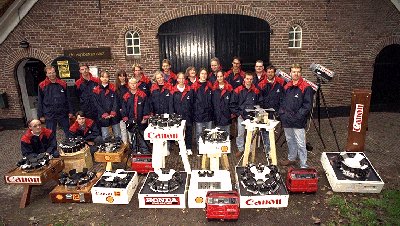 |
| On September 23, 1995 twenty DMS meteorobservers gather at the public observatory at Bussloo in advance of the DMS Leonids/alfa Monocerotids expedition to Spain. Note the photographic and video-equipment in front of the observers for three Dutch station and the Spanish station in Andalucia. (Photo by Kees Roos) |
In November of 1994, the first Leonid meteor outburst was reported by Dr. Peter Jenniskens (DMS and NASA/Ames Research Center), seen from Mountain View, California, and confirmed elsewhere. We set out to observe the anticipated outbursts of the Leonid in the following year, November 17, 1995. For that to happen, the Dutch Meteor Society mounted an observational expedition to the climatologically more favorable area around the city of Granada in Southeastern Spain, the nearest location with a fair chance of clear weather.
Moreover, Peter Jenniskens predicted the return of a spectacular outburst of the alpha-Monocerotid stream just days later. A brief display of meteors with rates peaking a 6 meteors per minute was expected to peak between 0h and 6h UT on November 22, 1995 (WGN June 1995; Astron. Astroph. 295 (1995), 206). The prediction was based on the hypothesis that a trail of dust in the orbit of long-period comets may tend to move around near the Earth's orbit by the combined influence of the major planets. On November 22, the planetary positions would be much the same as in 1935, when the shower was strong. This hypothesis differed from the assumption that a cloud of dust with a 10-year orbital period would be responsible for the alpha-Monocerotid outbursts. A likely scenario too, because alpha-Monocerotid outbursts were seen in 1925, 1935 and 1985. We were going to try and measure the orbital period of the alpha-Monocerotid meteors in order to distinguish among these theories.
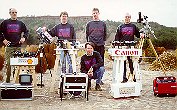 Five observers of team Alcudia-de-Gaudix pose with camera platforms and image intensified video cameras used to record the alpha-Monocerotid outburst from four locations in the province of Andalucia, Spain, in the night of November 22, 1995.
Five observers of team Alcudia-de-Gaudix pose with camera platforms and image intensified video cameras used to record the alpha-Monocerotid outburst from four locations in the province of Andalucia, Spain, in the night of November 22, 1995.
From left to right: Casper ter Kuile,
Koen Miskotte, Marco Langbroek, Jos Nijland and
Robert Haas
During the period of November 14 until November 23, 21 DMS Observers were going to establish three temporary meteor stations at the small villages of Almedinilla, Zaffaraya and Alcudia, about 80 kilometers distant of each other, in a geometric pattern favorable for multi-station photography and videography. Multi-camera photographic equipment capable to cover the whole sky above 5 degrees altitude were going to be employed on each site, as well as image intensified video equipment. In addition, spectrographic equipment would be employed in Almedinilla.
Goal of the expedition was to gather high precision photographic orbits from both streams as well as detailed visual observations of the outbursts. Similar activities are planned for future Leonid returns. Spanish observers of SMS was going to cooperate in the project and establish a fourth station, which would be supplied with photographic equipment by DMS. Peter Jenniskens planned a shadow Leonid campaign in the San Francisco area of California, which would allow covering a large part of the Leonid activity curve. Peter would then travel to Spain, where he would later establish a fifth station at Calar Alto observatory during the expected alpha-Monocerotids.
Following the prediction, a spectacular outburst of the alpha-Monocerotid stream has been observed by observers all over Europe on November 22, 1995.
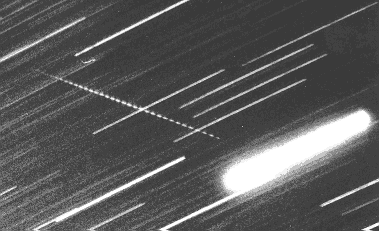 |
The event started around 1:10 UT, on November 22, and was all but over by 1:50 UT. The peak rate occurred near 1:29 UT, when up to 5 meteors per minute were recorded. This translates to peak Zenith Hourly Rates of about 500, the highest ever observed by any of us. All stations saw the event. Three meteors were recorded multi-station by the photographic cameras and seven were recorded multi-station by the video cameras. A thin layer of cirrus clouds, and a typical lack of bright alpha-Monocerotids were responsible for the low harvest of meteors. From the results, we have calculated that the orbits of the particles were of long orbital period, consistent with the hypothesis that a trail of dust in the orbit of a long period comet is occasionally directed into the Earth's path.
- P. Jenniskens, H. Betlem, M. de Lignie and M. Langbroek: "The Detection of a Dust Trail in the Orbit of an Earth-threatening Long-Period Comet"
in: THE ASTROPHYSICAL JOURNAL, 479:441-447, 1997 April 10
- M. Langbroek and P. Jenniskens: "De a-Monocerotidenuitbarsting van 21/22 november 1995: Visuale Resultaten"
in: Radiant, 18:122-124, 1997 January
- Dr. Peter Jenniskens personal website
- Leonids 98 Meteor Outburst Mission Homepage
- The detection of a dust trail in the orbit of an Earth-threatening long-period comet
- Global Meteor-Scatter Network
- Ames astronomer tracks comet "footprints" Dr. Peter Jenniskens
- NASA SCIENTIST REPORTS FIRST SIGNS OF COMING METEOR STORM , David Morse March 14, 1996; Ames Research Center, Mountain View, CA; RELEASE: 96-08
- Ames Scientist Reports Signs of Coming Meteor Storm Anomalous activity is probable first indicator; By David Morse
 |
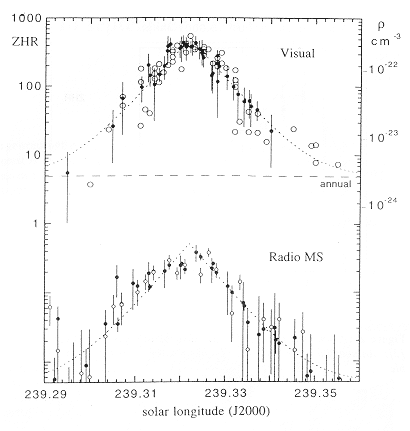 |
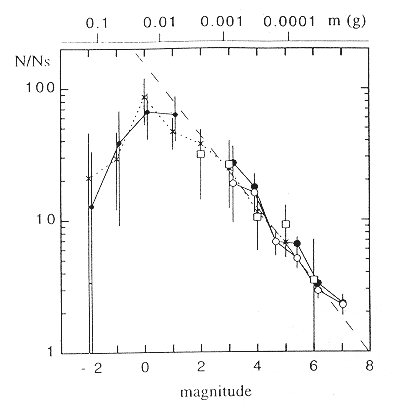 |
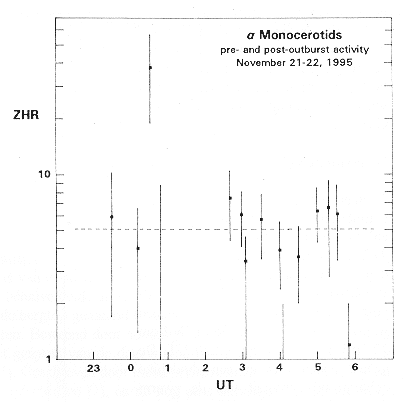 |
| Observer | Code | Location | No |
| Hans Betlem | HBE | Almedinilla (ES) | 32 |
| Marc de Lignie | MLM | Zafarraya (ES) | 58 |
| Ruud de Voogt | RVV | Almedinilla (ES) | 19 |
| Guus Docters van Leeuwen | GDV | Almedinilla (ES) | 74 |
| Engelien Geerdink | EGS | Almedinilla (ES) | 82 |
| Marco Langbroek | MLV | Calar Alto observatory (ES) | 60 |
| Koen Miskotte | KMH | Alcudia de Guadix (ES) | 107 |
| Fieke Mol | FMR | Almedinilla (ES) | 56 |
| Jos Nijland | JNB | Alcudia de Guadix (ES) | 81 |
| Iris Ooms | IOV | Almedinilla (ES) | 84 |
| Vera Pijl | VPS | Almedinilla (ES) | 91 |
| Alex Scholten | ASE | Eerbeek (NL) | 26 |
| Amold Tukkers | ATL | Lattrop (NL) | 37 |
| Olga van Mil | OMV | Almedinilla (ES) | 83 |
| Wendy van Mil | WMS | Almedinilla (ES) | 72 |
| Petrina van Tongeren | PTV | Almedinilla (ES) | 42 |
| Jaap van 't Leven | JLB | Zafarraya (ES) | 50 |
| Michiel van Vliet | MVO | Zafarraya (ES) | 81 |
| Annemarie Zoete | AZL | Almedinilla (ES) | 46 |
| Total | 19 | 6 | 1181 |
| Code | 95254 | 95260 | 95252 | 95255 |
| Year | 1995 | 1995 | 1995 | 1995 |
| Month | 11 | 11 | 11 | 11 |
| Day | 22.07 | 22.12 | 22.07 | 22.07 |
| N | 2 | 2 | 2 | 4 |
| stream | a-Mon | a-Mon | a-Mon | a-Mon |
| Mv | 0 | -1 | 0 | -2 |
| q | 0.50 | 0.48 | 0.51 | 0.50 |
| tol q | 0.02 | 0.01 | 0.01 | 0.01 |
| Q | -51.05 | 156.95 | -32.64 | -45.03 |
| a | -25.27 | 78.72 | -16.07 | -22.26 |
| 1/a | -0.04 | 0.01 | -0.06 | -0.04 |
| tol 1/a | 0.09 | 0.04 | -0.05 | 0.04 |
| e | 1.02 | 0.99 | 1.03 | 1.02 |
| tol e | 0.05 | 0.02 | 0.03 | 0.02 |
| i | 134.35 | 134.18 | 136.83 | 134.15 |
| tol i | 0.77 | 0.49 | 0.55 | 0.33 |
| w | 88.89 | 91.25 | 87.73 | 88.90 |
| tol | 3.08 | 1.36 | 1.88 | 1.52 |
| W | 59.33 | 59.43 | 59.32 | 59.33 |
| p | 148.21 | 156.95 | 147.06 | 148.23 |
| tol | 3.08 | 1.36 | 1.88 | 1.52 |
| V g | 63.2 | 62.6 | 63.9 | 63.2 |
| V h | 42.8 | 42.2 | 43.0 | 42.8 |
| V inf | 64.4 | 63.6 | 65.1 | 64.4 |
| V | 63.3 | 63.1 | 64.6 | 64.2 |
| tol V | 1.0 | 0.4 | 0.6 | 0.5 |
| H beg | 97.0 | 97.5 | 97.1 | 110.9 |
| H end | 85.0 | 84.1 | 85.2 | 81.3 |
| RA Geo | 117.14 | 117.20 | 117.85 | 117.08 |
| Dec Geo | 0.73 | 0.89 | 1.52 | 0.67 |
| COSZR | 0.66 | 0.80 | 0.66 | 0.68 |
| Q max | 49.39 | 53.79 | 28.70 | 85.10 |
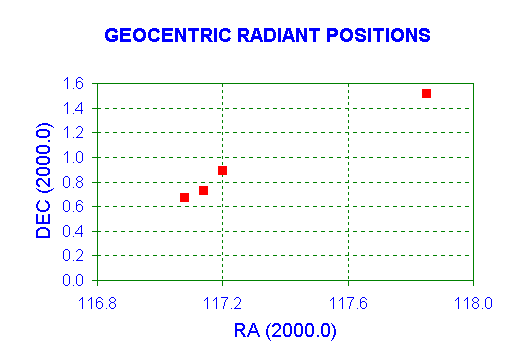
| Code | 95664 | 95665 | 95667 | 95668 | 95675 | 95679 | 95681 |
| Year | 1995 | 1995 | 1995 | 1995 | 1995 | 1995 | 1995 |
| Month | 11 | 11 | 11 | 11 | 11 | 11 | 11 |
| Day | 22.0563 | 22.059 | 22.0618 | 22.0632 | 22.0674 | 22.0701 | 22.0729 |
| N stations | 2 | 2 | 2 | 2 | 2 | 2 | 2 |
| Stream | a-Mon | a-Mon | a-Mon | a-Mon | a-Mon | a-Mon | a-Mon |
| Mv | 3 | 2 | 1 | 5 | 2 | 0 | 1 |
| q (AU) | 0.4803 | 0.4811 | 0.495 | 0.4743 | 0.4934 | 0.5087 | 0.4891 |
| tol q | 0.0119 | 0.0172 | 0.0115 | 0.023 | 0.0113 | 0.0115 | 0.0116 |
| a (AU) | 12.923 | 422.753 | -36.2904 | 26.8892 | -24.0179 | 214.485 | 251.592 |
| 1/a | 0.07738 | 0.00237 | -0.02756 | 0.03719 | -0.04164 | 0.00466 | 0.00397 |
| tol 1/a | 0.05526 | 0.08957 | 0.05812 | 0.1184 | 0.05868 | 0.05767 | 0.05706 |
| e | 0.9628 | 0.9989 | 1.0136 | 0.9824 | 1.0205 | 0.9976 | 0.9981 |
| tol e | 0.0257 | 0.0431 | 0.0291 | 0.0553 | 0.0294 | 0.0293 | 0.0279 |
| i | 133.379 | 134.31 | 134.479 | 133.796 | 134.627 | 134.074 | 134.105 |
| tol i | 0.6532 | 0.8288 | 0.6324 | 1.0687 | 0.6098 | 0.6186 | 0.6503 |
| omega | 92.7096 | 91.5178 | 89.482 | 92.8136 | 89.4854 | 88.3462 | 90.6068 |
| tol omega | 2.1727 | 3.22 | 2.0784 | 4.3788 | 2.0501 | 2.1016 | 2.1149 |
| Node | 59.3156 | 59.3182 | 59.3213 | 59.3224 | 59.3269 | 59.3299 | 59.3327 |
| tol Node | 0 | 0 | 0 | 0 | 0 | 0 | 0 |
| pi | 152.025 | 150.836 | 148.803 | 152.136 | 148.812 | 147.676 | 149.94 |
| tol pi | 2.1727 | 3.2232 | 2.0784 | 4.3788 | 2.0501 | 2.1016 | 2.1148 |
| V g | 61.8906 | 62.6849 | 63.1065 | 62.2356 | 63.2308 | 62.9082 | 62.7192 |
| V h | 41.5641 | 42.3571 | 42.6693 | 41.9908 | 42.8154 | 42.3331 | 42.3403 |
| V inf | 63.132 | 63.906 | 64.318 | 63.456 | 64.43 | 64.11 | 63.914 |
| V mean | 62.947 | 63.724 | 64.138 | 63.272 | 64.251 | 63.93 | 63.733 |
| tol v | 0.6463 | 1.028 | 0.6581 | 1.3777 | 0.6591 | 0.6572 | 0.6542 |
| H beg | 114 | 112.4 | 113.6 | 101.1 | 114.9 | 119.6 | 116.3 |
| H max | |||||||
| H end | 88.9 | 89.1 | 89 | 89 | 87.2 | 94.1 | 89 |
| RA | 117.238 | 116.941 | 117.187 | 116.893 | 117.099 | 117.759 | 117.205 |
| tol RA | 0.129 | 0.17 | 0.147 | 0.118 | 0.201 | 0.171 | 0.108 |
| DEC | 0.9409 | 1.379 | 1.1529 | 1.3 | 1.264 | 0.6287 | 1.1019 |
| tol DEC | 0.271 | 0.247 | 0.261 | 0.276 | 0.223 | 0.246 | 0.28 |
| RA Geo | 117.269 | 116.951 | 117.188 | 116.89 | 117.078 | 117.736 | 117.163 |
| DEC Geo | 0.6097 | 1.0633 | 0.8406 | 0.9794 | 0.9573 | 0.3109 | 0.7895 |
| Cos ZR | 0.618 | 0.637 | 0.64 | 0.646 | 0.657 | 0.645 | 0.672 |
| Q max | 42.5 | 42.5 | 46 | 29.5 | 44.2 | 32.8 | 26.5 |

Rates went up to about ZHR = 35, about three times the normal rates. An abundance of bright meteors resulted in many photographic successes. The video cameras were less effective in capturing this outburst. The peak of the event was over Europe or western Asia, hence favorable for the observers in Spain. In California, the observers saw only the beginning and end of the enhanced rates.
|
The logo of the DMS Leonids and alfa Monocerotids expedition to
southern Spain in november 1995. Design and production: Robert Haas |
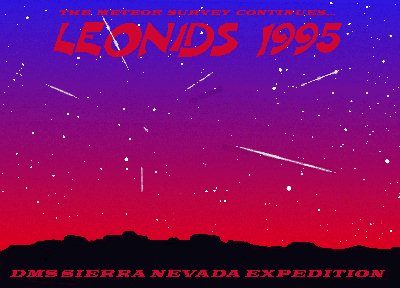 |
People that participated in the observing campaign were:
Dutch observers at Alcudia-de-Guadix were Robert Haas, Casper ter Kuile,
Koen Miskotte, and Jos Nijland; in Almedinilla, Hans Betlem, Engelien
Geerdink, Hans Klü, Guus Doctors van Leeuwen, Olga van Mil, Wendy van Mil,
Ruud de Voogd, Annemarie Zoete; at Calar Alto Observatory, Charlie Hasselbach,
Peter Jenniskens, and Marco Langbroek; observers at Zafarraya were
Jaap van't Leven, Michiel van Vliet, Klaas Jobse and Marc de Lignie.
Spanish observers at Chirivel were, among others, Luis Ramon Bellot and
Francisco Reyes Andres. Additional visual observations were obtained by
Alex Scholten in the Netherlands. We also thank Ilkka Yrjola, Peter Bus and
Ton Schoenmaker for their efforts in obtaining radio meteor scatter data.
The DMS expedition to Andalusia, Spain, has been made possible thanks to
financial and material support by the
Prins Bernhard Fund,
the Kerkhoven-Bosscha fund of Leiden University (dept. of astronomy),
the foundation Physica,
Shell Netherlands bv,
Honda power equipment,
CANON,
Delft Electronic Products,
Kodak,
Ilford
and Op den Kelder Technologie Support,
to all of whom we are greatly indebted.
Our special thanks go to Hans Betlem who organised the greater part of the DMS alfa-Monocerotids/Leonids expedition to Andalucia.
| Back to DMS homepage |
This page was last modified on May 5, 1998 by Casper ter Kuile and Hans Betlem |